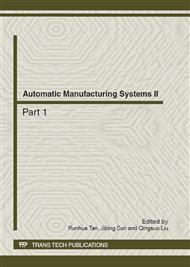p.1105
p.1109
p.1113
p.1120
p.1124
p.1132
p.1141
p.1145
p.1150
Establishment of Valve Control Mathematical Model of Hydraulic Differential Cylinder
Abstract:
From a practical point of hydraulic servo system, this paper researches on four-way servo valve working as three-way servo valve combined three-way pressure reducing valve forming differential form controlling asymmetric hydraulic cylinder characteristics using the classical control theory. According to the characteristics of hydraulic cylinder extends and retracts, it redefines the load pressure and load flow, establishes the load flow equation of control valve, the continuity equation of hydraulic cylinder and dynamic balance equations of the hydraulic cylinder which connected with the load, reaches the valve controlled asymmetrical cylinder system transfer function. Considering engineering practice, simplifying load types, it respectively obtains the transfer function of elastic load and none elastic load under the system which provides theoretical basis for analysing the static and dynamic characteristics of the valve controlled asymmetrical cylinder system.
Info:
Periodical:
Pages:
1124-1131
Citation:
Online since:
June 2012
Authors:
Price:
Сopyright:
© 2012 Trans Tech Publications Ltd. All Rights Reserved
Share:
Citation:


